Commentary &Independent Animation 03 Mar 2012 06:11 am
More Crits, Quips and Cracks
- Last week I wrote about my reading Andrew Osmond‘s BFI monograph for the film Spirited Away. I quite enjoyed the short book and immediately read through it twice. Of course, I also enjoy Miyazaki’s film Spirited Away, so I had a lot to visit in the read.
In the rear of the book, there are notes and references for further reading. One of these was a commentary article by Michael Barrier which is still posted on his site, about Monsters Inc. and Pixar’s animation as well as mention of a couple of Miyazaki films, Princess Mononkone and Spirited Away.
My first thought on going back and rereading Mike’s article was in how much the comment and material holds up over the years. There’s some very specific arguments being made about the animation of all the films mentioned, and I can’t take issue with much of what he has to say.
I’d like to quote a few paragraphs from this article:
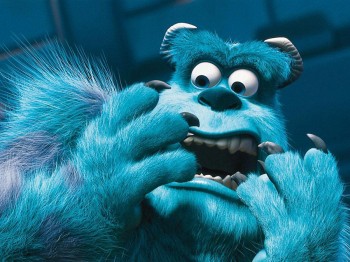 Computer animation’s technology has from all appearances advanced at an even faster rate than the techniques of the Disney animators in the thirties. It’s becoming clear, though, that, in contrast to what happened seventy years ago, there’s no necessary connection between mastering the technology and putting more convincing characters on the screen. When a character is covered with millions of precisely rendered hairs, and his on-screen environment is richly three-dimensional, it’s reasonable to expect him to move with a real creature’s subtlety. Sulley does not pass that test. He is less persuasive than many drawn characters whose caricatured movements are simpler and more direct. It is Sulley’s voice (by John Goodman) that brings him to life, far more than the animation; in that respect, the Pixar characters are indistinguishable from Homer Simpson or, for that matter, Huckleberry Hound.
Computer animation’s technology has from all appearances advanced at an even faster rate than the techniques of the Disney animators in the thirties. It’s becoming clear, though, that, in contrast to what happened seventy years ago, there’s no necessary connection between mastering the technology and putting more convincing characters on the screen. When a character is covered with millions of precisely rendered hairs, and his on-screen environment is richly three-dimensional, it’s reasonable to expect him to move with a real creature’s subtlety. Sulley does not pass that test. He is less persuasive than many drawn characters whose caricatured movements are simpler and more direct. It is Sulley’s voice (by John Goodman) that brings him to life, far more than the animation; in that respect, the Pixar characters are indistinguishable from Homer Simpson or, for that matter, Huckleberry Hound. And about Spirited Away:
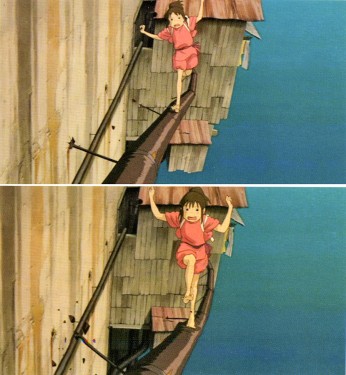 Stylization, the ready answer, or excuse, for Japanese animators’ cavalier handling of their characters, doesn’t really serve in Miyazaki’s case, because he is so good at atmospherics—his settings seem real even when the characters don’t. To the extent that Chihiro, Miyazaki’s ten-year-old protagonist, wins our sympathy, it’s not because the animation brings her to life (except perhaps in fleeting moments when she slips into the paralysis of fear), it’s because Miyazaki places her in an environment as persuasively weird as those in the most obvious of his sources, Lewis Carroll’s Alice in Wonderland and Through the Looking Glass. But how much more powerful the film would be—how much more involving—if Chihiro had been animated so that she were wholly present on the screen . . .
Stylization, the ready answer, or excuse, for Japanese animators’ cavalier handling of their characters, doesn’t really serve in Miyazaki’s case, because he is so good at atmospherics—his settings seem real even when the characters don’t. To the extent that Chihiro, Miyazaki’s ten-year-old protagonist, wins our sympathy, it’s not because the animation brings her to life (except perhaps in fleeting moments when she slips into the paralysis of fear), it’s because Miyazaki places her in an environment as persuasively weird as those in the most obvious of his sources, Lewis Carroll’s Alice in Wonderland and Through the Looking Glass. But how much more powerful the film would be—how much more involving—if Chihiro had been animated so that she were wholly present on the screen . . .Mike is definitely right. The animation of the early, pre-Brad Bird Pixar films is not quite sophisticated enough to take control of the well performed celebrity voices that dominate the characters. (Bird, I think, was able to coax bits of fine original animation out of the animators and the complex system of cgi animation.) Likewise, through Spirited Away, I see a simplicity in the animation of the characters. However, it is with this film that I believe some real animation starts to enter the Miyazaki films. The scene where Chihiro crosses a treacherous metal pipe outside the bath house. The character makes a strong change in personality with this animation, and it has to be taken note that this is not in the voice over but in the artwork. Miyazaki made the choice to change the personality here against the arguments of his animation director, and we can see that the character development has clearly stepped into the studio’s animation, no matter how slowly. From this point forward, Chahiro has a marked change in her character.
Yes, as Mike suggests, the atmospherics have strongly supported the obvious animation, up to this point, but I believe something stronger is entering the films.
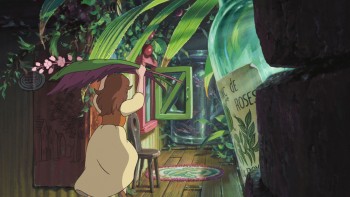 This to me is quite clear in seeing The Secret World of Arrietty. Things have taken an enormous leap, and some of the animation is very personable, completely without artifice and wholly based on human action and interaction. Certainly, it still has many wooden scenes, but there is enough original work in there, that I have to have enormous pleasure in witnessing real 2D animation making its presence felt. This non-generic animation is hard to find in western work, and that’s almost inexplicable to me.
This to me is quite clear in seeing The Secret World of Arrietty. Things have taken an enormous leap, and some of the animation is very personable, completely without artifice and wholly based on human action and interaction. Certainly, it still has many wooden scenes, but there is enough original work in there, that I have to have enormous pleasure in witnessing real 2D animation making its presence felt. This non-generic animation is hard to find in western work, and that’s almost inexplicable to me.
Mike Barrier in his commentary article on Disney’s Tangled has different thoughts about cgi animation. I have to say I don’t quite agree with him on this film, but I understand what he has to say.
- Where CGI is concerned, it seems to me that a complete naturalness in the characters’ movements, like that in parts of Tangled, does not limit the animators to a deadening literalness. Instead, it creates the potential for more subtle and expressive animation of a distinctly non-literal kind, just as the Disney animators’ growing mastery of hand-drawn animation in the 1930s meant that cartoon characters like the Seven Dwarfs could be more insistently present on the screen than characters that were drawn with superficially greater realism.
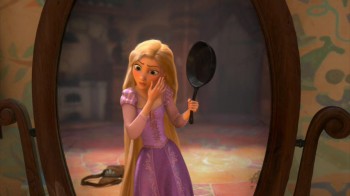 Where Mike sees glimmers of a reality in the animation, I see it all ripped away by generic popping movements, oftentimes covered with blurred motions. What you get are the slow moving gestures immediately followed by popping cartoon-like actions. This goes for both Rapunzel and her Prince. The end result is that their motions, to me, are identical, and there is no personality shining through beyond the voice acting (which I don’t think is great. Mandy Moore couldn’t be more generic.) The realistic movements, to me, are with the witch/stepmother. Here, Donna Murphy‘s voice over has a lot to do with the character, but I don’t discount what the character, herself, is doing in the animation.
Where Mike sees glimmers of a reality in the animation, I see it all ripped away by generic popping movements, oftentimes covered with blurred motions. What you get are the slow moving gestures immediately followed by popping cartoon-like actions. This goes for both Rapunzel and her Prince. The end result is that their motions, to me, are identical, and there is no personality shining through beyond the voice acting (which I don’t think is great. Mandy Moore couldn’t be more generic.) The realistic movements, to me, are with the witch/stepmother. Here, Donna Murphy‘s voice over has a lot to do with the character, but I don’t discount what the character, herself, is doing in the animation.
In short, I have to say that there’s a veritable treasure trove of material on Mike Barrier‘s site. Dig in and take a look at some of these articles. His is a singular, articulate voice, and there’re books worth of ideas and living commentary on this site. And it’s all for free. but then if you really love animation, you already know this.
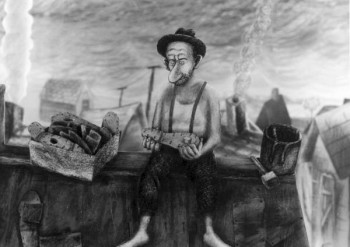 - I’m pleased to see that Ian Lumsden has returned to posting more videos on his blog, The Animation Blog. Ian’s taste is quite fine, and the work posted is always of a generally high caliber. Recently he posted Eugene Federenko and Rose Newlove‘s beauty of a film, The Village Idiots. Federenko is an artist of the most devoted kind, and to watch his films is always my pleasure. Believe me, I’ve seen many of them MANY times, and the welcome doesn’t wear thin for me.
- I’m pleased to see that Ian Lumsden has returned to posting more videos on his blog, The Animation Blog. Ian’s taste is quite fine, and the work posted is always of a generally high caliber. Recently he posted Eugene Federenko and Rose Newlove‘s beauty of a film, The Village Idiots. Federenko is an artist of the most devoted kind, and to watch his films is always my pleasure. Believe me, I’ve seen many of them MANY times, and the welcome doesn’t wear thin for me.
Such films as Mr. Federenko’s makes me long for the National Film Board of even fifteen years ago when capital was a little more available, and the beautiful films
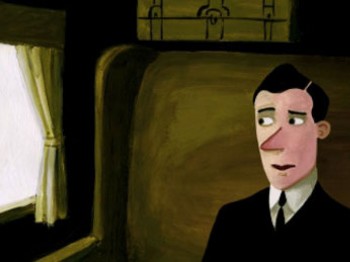 were plentiful. (I’m grateful for any short they’re still making and I wait for them at Festivals and Academy runoffs. This year’s Wild Life by Wendy Tilby and Amanda Forbis and Dimanche by Patrick Doyon were both superb gems, and those filmmakers deserved the high praise they received in being nominated for the Oscar. I’d hoped for Wild Life to win, but am pleased they got as far as they did. It’s story is the best of those that were in the running.)
were plentiful. (I’m grateful for any short they’re still making and I wait for them at Festivals and Academy runoffs. This year’s Wild Life by Wendy Tilby and Amanda Forbis and Dimanche by Patrick Doyon were both superb gems, and those filmmakers deserved the high praise they received in being nominated for the Oscar. I’d hoped for Wild Life to win, but am pleased they got as far as they did. It’s story is the best of those that were in the running.)
- The Oscars came and went, and neither of my animation choices won, though I’m not ocmpletely dissatisfied with Rango‘s win. At least it was the more eccentric of the cgi films.
As for The Fantastic Flying Books of Mr. Morris Lessmore, I find the film completely opaque. It’s obviously and attractive and seems to think it’s about something, but I’ll be damned if I can understand it. Except that the guy likes books and doles them out from his ersatz library in the middle of nowhereland. Oh yes, he’s lonely. All he has is a Humpty Dumpty animated illustration book to keep him in good company.
This is one of those design-y stories where everything is built around conceit, and the audience is fed schmaltz about nothing. It’s a poor meal to swallow.
A film like Wild Life is about many things and told its story beautifully, graphically and was well animated.
Just the same, congratulations to William Joyce and Brandon Oldenburg
I’m pleased that they’re onto other projects at Moonbot Studio.
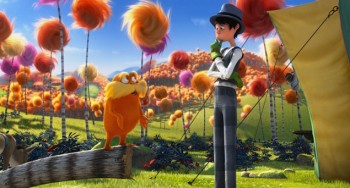 - Of the local critics, AO Scott of the NYTimes was particularly harsh on THE LORAX
- Of the local critics, AO Scott of the NYTimes was particularly harsh on THE LORAX
- Don’t be fooled. Despite its soft environmentalist message “The Lorax†is an example of what it pretends to oppose. Its relationship to Dr. Seuss’s book is precisely that of the synthetic trees that line the streets of Thneedville to the organic Truffulas they have displaced. The movie is a noisy, useless piece of junk, reverse-engineered into something resembling popular art in accordance with the reigning imperatives of marketing and brand extension.
and then later in the review . . .
- In the film as in the book, the Once-ler ravages the landscape and destroys the Truffula trees to manufacture thneeds, knitted garments that have multiple uses but no real utility. Demand for them is insatiable for a while, and then, once the trees are gone, the thneeds are forgotten, partly because nobody really needed them in the first place. There is an obvious metaphor here, but the movie is blind to it, and to everything else that is interesting or true in the story it tries to tell.
It sounds like the trailer I saw for the film, as I waited patiently through many animated junk trailers, on the way to see The Secret World of Arrietty in a theater. The film screens for Academy members on this upcoming Thursday. Maybe I’ll muster the courage to sit through it.
But then, Eliabeth Weitzman in the NYDaily News seemed to enjoy the film calling it, “A Tree-mendous Animated Movie.”
- While softening Geisel’s darker themes, they still meld a valuable message into catchy songs, bright images (nicely done in 3D) and funny characters.
- Even adults are likely to walk out wondering how our own society has strayed so far from any sensible path … before hopping into their Lorax-approved Mazda and heading to IHOP for some Truffula Chip pancakes.
And, finally, the NYPost‘s Kyle Smith is merciless:
- I am the critic, I speak to displease:
“The Lorax†is awful, like chronic disease.
There’s no fun in “The Lorax,†no joy in its theme;
It’s as boring as sales tax.
I’m ready to ream.

on 03 Mar 2012 at 10:34 am 1.BT said …
Hi, although I fully admit that I am probably less informed about the nitty-gritty of animation than the usual commenters on your blog, I hope my following thoughts/queries have somewhat of a handle on the subject at hand.
So…I wonder if there are differences in attention to character animation between Miyazaki-directed Ghibli films and those Ghibli films directed by others?
Yoshifumi Kondo’s Whisper of the Heart, for instance, also seemed to exhibit more attention to subtle character animation than other Ghibli films. This may not be a total surprise since Kondo had served as an animation director for a longer period of time than Miyazaki did, and he spent a chunk of his career acting as animation supervisor or director of many of Ghibli’s less fantasy-action oriented earlier films, like Kiki’s Delivery Service, Grave of the Fireflies, and Only Yesterday.
I probably wouldn’t say Isao Takahata’s films exhibit much notable difference in character animation than Miyazaki’s, but his films are so different from the Studio Ghibli norm that it’s difficult to really try to make a comparison of animation differences without getting sidetracked by the vast number of other idiosyncratic elements in Takahata’s films.
Hiromasa Yonebayashi, at just 38, has a much smaller resume to his credit so it’s difficult to see if his background has any influence over Arrietty’s uptick in character animation, or if it’s more the result of an improved studio-wide commitment to it.
on 03 Mar 2012 at 12:05 pm 2.Michael said …
I must say that I didn[t find the animation of WHISPERS OF THE HEART any more original than the Takahata animation. The characters seem to go through their paces from one movement to the other.
To me, it was only with some moments in PRINCESS MONONOKONE and SPIRITED AWAY that I started seeing original character animation. The movement in ARRIETTY is wholly different and much more alive. I hae to give credit to the director since it stands out so obviously to me. I’m not completely satisfied with the ARRIETTY designs, but every movement seemed to have something original in them.
on 03 Mar 2012 at 3:00 pm 3.Scott said …
I’d have to say that barrier’s commentary is most often completely off the mark. Where he’s worthwhile is when it comes to research and laying out historical fact. Where he falls completely apart more often than not is in his speculation–which tends to be often ill informed and emotional (although the word “moody” would probably be more apt.).
on 03 Mar 2012 at 3:08 pm 4.Michael said …
Scott, I completely disagree with you. Mike Barrier is the most astute animation reviewer out there. His knowledge of animation, animation history and film is enormous and it all plays into his reviews. There is not one article or review he has written that hasn’t had me thinking seriously about the subject – in a larger scope than others would comment. Only a few others have as much to say.
on 03 Mar 2012 at 4:51 pm 5.BT said …
Interesting, Michael. Perhaps you could devote a blog post or two one of these days breaking down some of the other sequences that impressed you in Mononoke or Spirited Away, or make a comparison-contrast between later Ghibli and early Ghibli with a few choice examples.
You’ve made a few recent posts discussing “popping” and “smear” motions in many western animated features (such as that interesting TANGLED post a few days ago), and have made some comments about “real” and “cartoony” animation, which I’ve found to be quite deserving of more visual analysis, especially on the subject of “real” movements. I think I’m beginning to grasp where you’re coming from, but more visuals always helps!
on 03 Mar 2012 at 5:50 pm 6.Nate said …
Micheal,
You make a reference to “pre-Brad Bird” Pixar films. I’m wondering if you can expand on that a bit more, because, I must admit, I’ve never understood why Brad Bird’s Pixar films are seemingly placed above all others. Maybe I’m not very observant, but I don’t see distinct artistic and personal director choices coming through each Pixar movie. It has always seemed to me that large-scale Hollywood animated features have no real personal identity.
I have never felt that the “autuer theory” fits within the context of these movies. For instance, I can watch a Scorsese movie and know that it’s a Scorsese movie, but that doesn’t seem to be the case with animated features.
A slight exception to this might be Chris Sanders. He has a distinct character design style that can be identified between movies. Stitch from “Lilo & Stitch” and the main dragon from “How to Train Your Dragon” have similarities. That’s about as far as it goes, however.
If the credits were kept secret, would one really be able to say who directed which Pixar movie?
I’m not trying to diminish Brad Bird’s talent, and I wish that Hollywood animated features were more identifiable by director than studio. It’s simply a question I’ve had for a while after reading so many critics and people in the animation community specifically praise Bird’s involvement on a Pixar film more so than anyone else.
on 03 Mar 2012 at 7:45 pm 7.Ian Lumsden said …
Thank you for the kind words, Michael. I retired early from my teaching role and travelled the world for a time as well as sponsored (it’s one word for it) five grandchildren. Now back to earth I have started writing up my blog again.
As ever I turn to your erudite pages for inspiration. “Erudite” is the most appropriate word I can think of. Whatever, you write well and knowledgeably.
on 03 Mar 2012 at 8:18 pm 8.Michael Barrier said …
Wow, is it ever flattering to have you quoting something I posted almost nine years ago (one of the first posts on my website, actually)!
I’ve warmed to both Monsters, Inc. and Spirited Away in the years since 2003; not that I disliked them before, but seeing them again on DVD, more than once, has made their virtues plainer and their shortcomings (which I think are still there) less troublesome. I watched Spirited Away again just a few weeks ago, in the company of four little girls who complained loudly about its length but just as loudly rejected my suggestion that I turn it off.
As for Tangled, I’m sure you’re right about much of its animation, but I don’t think the scenes that I remember best, and that impressed me most, are like that. I should probably see it again, too. And I certainly plan to see The Secret World of Arrietty, I hope in the next few days.
on 06 Mar 2012 at 6:11 pm 9.Elliot Cowan said …
The Lorax is awful.
on 12 Dec 2024 at 2:59 pm 10.Mejo Kallamthanam said …
“Scott, I completely disagree with you. Mike Barrier is the most astute animation reviewer out there. His knowledge of animation, animation history and film is enormous and it all plays into his reviews. There is not one article or review he has written that hasn’t had me thinking seriously about the subject – in a larger scope than others would comment. Only a few others have as much to say.”
I agree that Michael Barrier has lots of knowledge, but I don’t like it when he’s too negative. I remember the last chapter of his book Hollywood Cartoons (which is a pretty good book) is just him ranting about the then state of animation…in 1999.